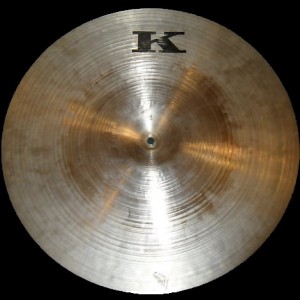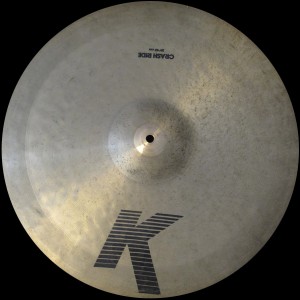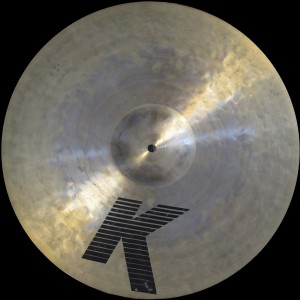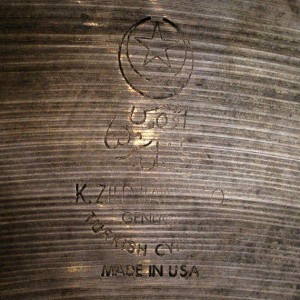The (Avedis) Zildjian company started making K Zildjian cymbals in a factory in Medutic, Canada in 1977. They brought a few cymbalsmiths from Istanbul to Canada at the time. This article provides some discussion of it:
Iero, Cheech. 1979. Cymbal talk with Zildjian’s Lenny Dimuzio. Modern Drummer 3(2):20-22.
Canadian K Zildjians (1977-1979)
 |
The K Zildjian stamp from Canada was a copy of the “new stamp” from Istanbul. Here is another example of a Canadian K, this one missing the words “made in Canada”, which was apparently common. |
 |
Underside of the Canada K has a medium sized letter K with a font that uses serifs. |
Later in 1979, Avedis Armand Zildjian and his cousin Mikhail Zilcan both died, and everything changed. Lawsuits ensued. Within a few years the Canadian factory would be producing Sabians, and the A Zildjian Company would make K Zildjians in Norwell, Massachusetts.




Thank you…..After years of asking around I finally got to the right place….I’ve got a unlathed 20 inch EAK ride…..love it to death…..But most of the pictures show machine grooves…..mine is just hammered. But I’d love to learn more….Once again thanks….Brad Henry
I’m glad this website is helpful to you. Regarding your cymbal: I would guess that it is “very finely lathed” as opposed to unlathed. A finely lathed cymbal may lack tonal grooves after the final lathing, whereas an unlathed cymbal will be very rough and heavy in weight, and it will sound very different.
If I’m correct, you’re actually referring to the problem of photography that captures the light bouncing off of the circular grooves of the lathing, while failing to capture light bouncing off of the irregular hand-hammering that belies the lathing.
i have an old 18″ K ride that has that irregular hammering and the stamp is pretty faded on one side but it is clearly the same stamp as the EAK on here. The only difference is mine actually says Zildjian on the bottom instead of having the huge K like it does on the top. Was that something that was done with some of them? or does that make it a different model?
Sorry Alex, but it sounds like you have a cymbal from after the EAK era. There are plenty of wonderful cymbals from 1981-1984 that also seem to have irregular hammering and the similar stamp, but only the ones with a big K on both sides qualify as EAK.
thanks for the respose rob, its still a great pie i got. i use it as an aux ride since it doesn’t crash much and its very heavy plus its not huge so i can sneak it right on top of my other ride. i was just curious since the stamp on mine is the same. i still love my baby.
great site btw!
They continued stamping big ‘K’s on the bottom long after 1981. I personally own several eAKs from the mid-80s. A couple of them even have the wider lathing from the “Zildjian-on-the-bottom” era, but a big ‘K’ on the bottom of the cymbal!
Check out the Steve Gadd/Tony Williams Zildjian ads from ‘84… I think they stopped putting ‘K’ on the bottom around 1985-86.
Also, I personally know people who went to the Norwell plant and to the ‘vault’ and picked out EAKs as late as 1986. Surely the cymbals they had in the vault weren’t 5+ years old…? One of my friends went with Dave Weckl, when Dave actually BOUGHT EAKs in about ’85 (I think).
Lastly, as far as them being ‘hand-hammered’ I read a guy from Zildjian saying that the early “hand-hamering techniques” became too expensive, so they switched to machines–just not sure when. They very easily could have machine-hammered Ks with the big K on the bottom. I think one is not part and parcel with the other. (You defined ‘EAK’s as having the ‘big K on the bottom’–which is right!) Except for the hand-hammering part. I think the machine hammering was still ‘random hammering’ it was just done by a guy guiding a machine, instead of holding an actual hammer…(kind of doesn’t matter, to me anyway…).
Funny how they tried to re-introduce the EAK-like Zildjians in the early 2000’s. I hated them. They put a big ‘K’ on the bottom, because they figured we would think it was way-cool. They are nothing like EAKs…
Thanks for your excellent Web site, though!
Best,
Tad
p.s.–I play Yamaha drums and Zildjians, and I really don’t play Yamaha or Zildjian stuff from later than ’90. In my opinion, that’s when all the best stuff was made…(1980-1990).
Thanks for sharing this information, Tad, but I respectfully disagree that this image is an EAK. My understanding is that EAKs have “a big letter K stamped on the bottom of the cymbal” but this appears to be the top of a cymbal. Also, I don’t see your attached ‘brilliant’ EAK images?
One comment on the EAK’s, Zildjian introduced the USA made K’s in late 1982.
Hi Rob, I’d like to post some images of the K cymbals I have. There’s a Constantinople 12″ – noted on your other webpage, I think an EAK, some Canadian hi hats, and a 22″ ride and a 16″ crash both with the 1967-77 Istanbul stamp. They all sound great. I’m trying also to value them for insurance purposes so any clues on this would be helpful. Thanks
Great site! Do you accept submissions of stamp photos? I imagine, if you do, you must have plenty. I have an ancient K Constantinople with ‘ZILDJIAN’ in letters 1mm high. Also, a pretty good Canada made K with the goofy looking Arabic (looks like Kandinsky) and a very shallow ‘MADE IN CANADA’ still barely visible.
Also, some super clean Zenjian, Alejian, Abex, Zilco, Stanople, Conn, Beverley, Kamala, etc. photos if you were interested. I’d love to share them with the Cymbaloonies of the world.
Thanks for your ‘Time’ (lines)
Ed
I gave Ed my email and here is what he sent me. Alphabetical order. Photo credit: Ed Campbell.
Hey Rob,
WOW! Thank you for posting the photos I sent and adding your expert comments. This is a great resource you’re providing to ‘the world’! I will share any Cymbalic uniquities I happen upon in the future. (I’ll work on getting a more focused image of that 1st Stamp K.)
A Fan! Ed
Hi, I have a 20″ K Ride with the K almost polished off the top but a strong K on the bottom. I’m confused because it has a serial number. I didn’t think EAK’s had serial numbers?? Any advice would be helpful. Thanks, Chuck
Great Site! I have a set of 14″ hats and a ride stamped Avedis Zildjian, Made in Canada. I think they are mid 70’s. I found your history page regarding Canadian K’s, what is the history of these? Were they made in the same factory as the K’s? Thanks!
Dear sirs,
Good day!
This is annie from Zhangqiu Jinshengyuan Musical Instrument Co.,Ltd which is a family-owned factory located in Jinan City,Shandong Province,China.
We produce all kinds of percussion and wind instruments,such as Cymbals,Guitars,Drums,Saxophones,Flutes and so on.We also supply OEM Services for you.Our products have been sold all over the world and highly appreciated by our costomers both home and abroad.
If you would like,we can send some samples for your test.Our products include high grade,medium grade.low grade,would you like to tell me your request? Then we can recommend the most suitable model with our best quotations to you.
Best regars and look forward to your early reply.
Annie
Zhangqiu Jinshengyuan Musical Instrument Factory
TEL: 0086-531-83329181
FAX: 0086-531-83329181
MOBILE: 0086-15552850479
WEBSITE: http://cymbal.en.alibaba.com
SKYPE:annie-jinshengyuan
EMAIL: arborea03@jsycymbals.com
MSN: jinshengyuan03@hotmail.com
I’m sorry, but to be precise, the EAK was produced from 1981/1982 (they appear in zildjian price list of the 1 january 1983 for first time) until 1987… and the eak production was divided in II series: one with the letters on the top of cymbal turned inside, and the II with the letter turned out…
I have all the original price lists, on 1 June 1979 there are NO K cymbals in the catalog, only Avedis Zildjian. In 1983 there are Avedis Zildjians, K Zildjians and Amir cymbals.
About the Canadian K Zildjians you are right…
I’m sorry about my English, but I’m Italian…
Thank you for your job!!!
Buona sera, Matteo. Spero è ok ho cambiato il tuo Inglès in modo che non sono probleme.
Thank you for your comment. I have heard that EAKs were first introduced to the market in late 1982. My understanding is that when the senior Ziljians died, the A company began producing EAKs in USA, and the Canadian lines eventually lead to Sabian. If EAKs are first retailed in 1982/83, that does not mean they were not produced in 1980.
Also, I am hesitant to attribute EAK status to the later cymbals (1983 to 1987). I realize this is controversial.
Its great sounding cymbal and I’m interested in dating it.
From the info gathered from this site is suspect it is a Canadian produced cymbal. – there is no indication of country of origin.
Vin Pearson.